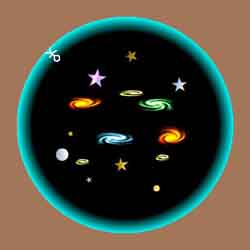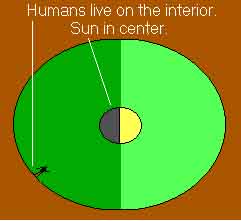
Humans live on the interior; with the universe in the center.
Instead of saying that humans live on the outside surface of a hollow planet, sometimes called a “convex” hollow-Earth hypothesis, some have claimed that our universe itself lies in the interior of a hollow world, calling this a “concave” hollow-Earth hypothesis. The surface of the Earth, according to such a view, might resemble the interior shell of a Dyson sphere. Generally, scientists have taken neither type of speculation seriously.
Cyrus Teed, an eccentric doctor from upstate New York, proposed such a concave hollow Earth in 1869, calling his scheme “Cellular Cosmogony”. Teed founded a cult called the Koreshan Unity based on this notion, which he called Koreshanity. The main colony survives as a preserved Florida state historic site, at Estero, but all of Teed’s followers have now died. Teed’s followers claimed to have experimentally verified the concavity of the Earth’s curvature, through surveys of the Florida coastline making use of “rectilineator” equipment.
Several twentieth-century German writers, including Peter Bender, Johannes Lang, Karl Neupert, and Fritz Braun, published works advocating the hollow Earth hypothesis, or Hohlweltlehre. It has even been reported, although apparently without historical documentation, that Adolf Hitler was influenced by concave hollow-Earth ideas and sent an expedition in an unsuccessful attempt to spy on the British fleet by aiming infrared cameras up into the sky (Wagner, 1999).
The Egyptian mathematician Mostafa Abdelkader authored several scholarly papers working out a detailed mapping of the concave Earth model. See M. Abdelkader, “A Geocosmos: Mapping Outer Space Into a Hollow Earth,” 6 Speculations in Science & Technology 81-89 (1983). Abstracts of two of Abdelkader’s papers also appeared in Notices of the American Mathematical Society, (Oct. 1981 and Feb. 1982).
In one chapter of his book On the Wild Side (1992), Martin Gardner discusses the hollow Earth model articulated by Abdelkader. According to Gardner, this hypothesis posits that light rays travel in circular paths, and slow as they approach the center of the spherical star-filled cavern. No energy can reach the center of the cavern, which corresponds to no point a finite distance away from Earth in the widely accepted scientific cosmology.
A drill, Gardner says, would lengthen as it traveled away from the cavern and eventually pass through the “point at infinity” corresponding to the center of the Earth in the widely accepted scientific cosmology. Supposedly no experiment can distinguish between the two cosmologies. Martin Gardner notes that “most mathematicians believe that an inside-out universe, with properly adjusted physical laws, is empirically irrefutable”. Gardner rejects the concave hollow Earth hypothesis on the basis of Occam’s Razor.
In a trivial sense, one can always define a coordinate transformation such that the interior of the Earth becomes “exterior” and the exterior becomes “interior”. Such transformations would require corresponding changes to the forms of physical laws; the consensus suggests that such theories tend towards sophism.

